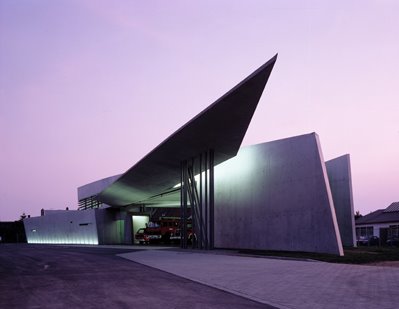Zaha Hadid at the Guggenheim
Architect/designer Zaha Hadid's story is almost as interesting as her work. Born in Iraq, long based in London, Hadid spent almost 20 years shopping around her ideas using her trademark, nearly abstract paintings, or "testing fields".
They look like this:

Needless to say, it was a tough sell.
Finally, whomever was in charge of building the Vitra Fire Station in Germany understood her vision, and in 1994, Hadid saw her first creation come to life. Ten years later she became the first woman to win the Pritzker Prize (Quick: name another woman architect. Besides Maya Lin.), and her signature style—lacking an art critic's vocabulary, I'll call it "fluid yet explosive"—has made her designs among the most sought after in the world.

Anyway: the Guggenheim show. There is much to love here. Hadid's kitchen in the museum's highest gallery is beautiful, fun, original (I especially liked the cabinets), as is the car she designed, and her furniture, and her lighting fixtures, all on display in the alcoves as you make your way down the ramps. (An aside: I always go top to bottom at the Guggenheim, even though that usually means I'm reversing the chronology.) Hadid's buildings are stunning, both in concept and in the way they function in the world. She combines forms and textures and lines in striking, unusual ways, and often makes brilliant use of concrete, which, as DGlass always says, can be so warm and elegant when done correctly (and, as we all know from pick-just-about-any-municipal-building, so creepy and oppressive when done wrong). My personal favorite is her BMW plant, which just opened this year and ingeniously combines a working factory and the carmaker's corporate offices into one building. Be sure to watch the video on this. And also check out the video on what Hadid designed for the museum's open interior—it looks amazing—but, unfortunately, it seems they couldn't pull off the engineering.
 But there are problems. The many photographs of her finished projects, her works-in-progress, and her proposals are placed on walls so close to the ramp that it's extremely difficult for an old man with increasingly poor eyes to stand far back enough to really appreciate them. Also, neither one of were convinced by Hadid's paintings (reminiscent of cheesy sci-fi illustrations, we thought), and these take up fully half the exhibition space. It helped, then, that DGlass is a Guggenheim member, and I rode along for free.
But there are problems. The many photographs of her finished projects, her works-in-progress, and her proposals are placed on walls so close to the ramp that it's extremely difficult for an old man with increasingly poor eyes to stand far back enough to really appreciate them. Also, neither one of were convinced by Hadid's paintings (reminiscent of cheesy sci-fi illustrations, we thought), and these take up fully half the exhibition space. It helped, then, that DGlass is a Guggenheim member, and I rode along for free. The Hadid show will be up until October 25. Jackson Pollack's drawings—a few of which are quite striking, either using colors not usually associated with the artist, or almost minimalist in their execution—will be there until September 29, and are definitely worth a look.
The Hadid show will be up until October 25. Jackson Pollack's drawings—a few of which are quite striking, either using colors not usually associated with the artist, or almost minimalist in their execution—will be there until September 29, and are definitely worth a look.

0 Comments:
Post a Comment
<< Home